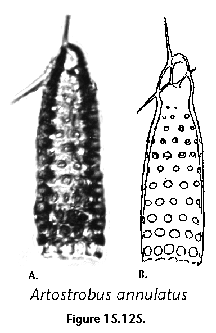 |
Artostrobus annulatus (Bailey) (Figure 15.125). Cephalis cup-shaped, poreless,
with a thin apical horn. Thorax cylindrical, with
circular (proximally) to subrectangular (distally) pores
in transverse rows, increasing in size toward the base.
Shell height: up to 160 Ám. Ref: Riedel (1958), Petrushevskaya (1967).
|
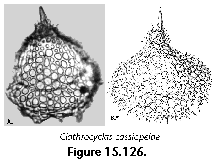 |
Clathrocyclas cassiopeiae Haeckel (Figure 15.126). Small cephalis with a stout
apical horn and many smaller spines. Thorax large,
campanulate, with irregular pores. Abdomen short,
truncated, with ragged, spiny termination. Shell height:
100-200 Ám. Ref: Haeckel (1887).
|
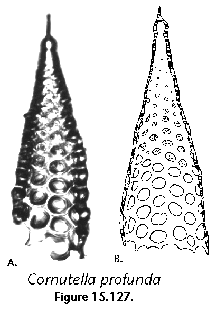 |
Cornutella profunda Ehrenberg (Figure 15.127). Narrow, bilocular conical shell
with very small subspherical poreless cephalis with or
without apical horn. Pores on thorax circular, increasing
in size toward the base. Sell height: 120-230 Ám. Ref: Riedel (1958), Nigrini (1967).
|
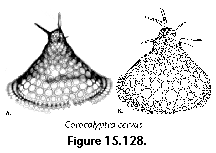 |
Corocalyptra cervus (Ehrenberg) (Figure 15.128). Cephalis with a large apical
horn, often forked distally. Thorax large, campanulate,
with regular, polygonal pores in transversal rows
increasing in size distally. Abdomen restricted to a
narrow brim with several rows of small pores. Shell
height: 100-200 Ám. Ref: Benson (1966).
|
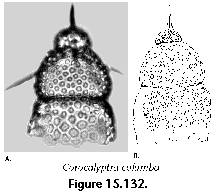 |
Corocalyptra columba (Haeckel) (Figure 15.132). Subspherical cephalis partly
submerged into cupola-shaped thorax, provided with a
large apical horn. Thorax with three small wings. Abdomen
cylindrical. Shell height: ca. 100-120 Ám. Ref: Haeckel (1887), as Pterocorys columba.
|
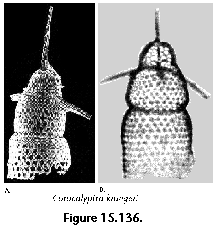 |
Corocalyptra kruegeri Popofsky (Figure 15.136). Generally similar to C.
columba; cephalis larger, thorax and abdomen
cylindrical. Shell height: ca. 80 Ám. Ref: Popofsky (1913).
|
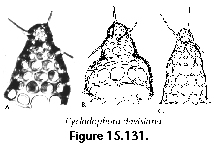 |
Cycladophora davisiana (Ehrenberg) (Figure 15.131) [=Theocalyptra davisiana, ?Artostrobus
jorgenseni]. Shell conical to campanulate. Cephalis
subspherical, sparsely perforated, usually with two
spines. Thorax conical to cylindrical, with circular
(proximally) to quadrate (distally) pores increasing in
size toward the base. Abdomen, when present, flared out,
wider than thorax, with quadrate pores. Petrushevskaya (1967) described three subspecies of this
form, of which C. davisiana (Ehrenberg) davisiana
Petrushevskaya (Figure 15.131b) and C. davisiana
(Ehr.) cornutoides (Petrushevskaya) (Figure
15.131c) are often used in current literature (the last
one is probably synonymous with Artostrobus jorgenseni).
Shell height: ca. 100 Ám. Ref: Riedel (1958), Petrushevskaya (1967), Bj°rklund and
Ciesielski (1994).
|
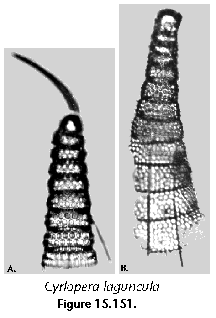 |
Cyrtopera laguncula Haeckel (Figure 3O; 15.151) [=Cyrtolagena laguncula, Stichopera
pectinata]. Very typical multisegmented shell with
conical outline and clearly marked constrictions; last
segment may be open or closed. Shell height: 150-250 Ám.
Ref: Petrushevskaya
(1971a).
|
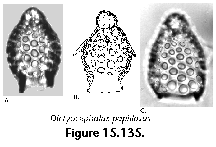 |
Dictyocephalus papillosus
(Ehrenberg) (Figure 15.135) [=Carpocanarium papillosum].
Two-segmented, thick-walled shell. Cephalis spherical.
Thorax oval, with circular, usually framed pores, with
three short wings, ending in a narrowed, poreless
peristome. Shell height: 70-90 Ám. Ref: Petrushevskaya (1967).
|
 |
Dictyophimus gracilipes Bailey (Figure 15.142) [=Pseudodictyophimus gracilipes,
Dictyophimus clevei]. Cephalis partly submerged
into thorax, bears a large apical horn. Thorax pyramidal
or conical, mouth open or closed, with three conspicuous
legs (dorsal and lateral spines). Shell height (without
feet): 55-90 Ám. Ref: Petrushevskaya
(1971a).
|
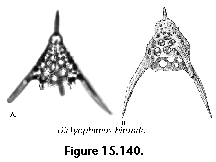 |
Dictyophimus hirundo (Haeckel) (Figure 15.140) [=Pterocorys hirundo].
Cephalis, globular, sometimes spiny, with a stout,
three-bladed apical horn. Thorax truncate-conical to
campanulate, spiny, with large circular pores and three
ribs which extend into massive, divergent feet. Highly
variable species (species group?). Shell height (without
feet): 50-100 Ám. Riedel (1958), Nigrini and Moore
(1979).
|
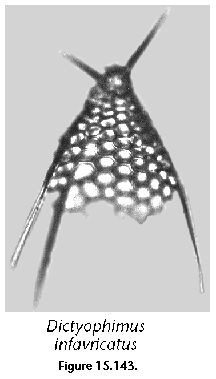 |
Dictyophimus infabricatus Nigrini (Figure 3Q; 15.143). Similar to D. hirundo, but
shell is thinner and pores are larger; cephalis usually
wih two horns (apical and vertical spines), feet are
smaller. Shell height (without feet): 90-200 Ám. Ref: Nigrini and Moore
(1979).
|
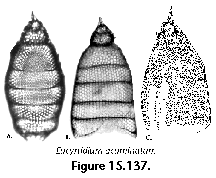 |
Eucyrtidium acuminatum (Ehrenberg) (Figure 15.137) [=?Eucyrtidium hexagonatum].
Small subspherical cephalis with apical horn. Thorax
small, inflated, thick-walled. Abdomen and four-five
post-abdominal segments thin-walled, with pores arranged
in longitudinal rows. Shell height: 120-200 Ám. Eucyrtidium
hexagonatum Haeckel is closely related to this
species; according to Nigrini (1967) it can be distinguished from E.
acuminatum by the sharp change in contour at the
lumbar stricture. Ref: Nigrini and Moore
(1979).
|
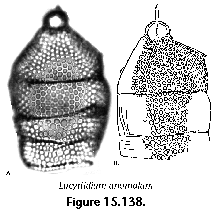 |
Eucyrtidium anomalum (Haeckel) (Figure 15.138). Cephalis spherical, partly
submerged into the large, assymetric, conical,
thin-walled thorax. Abdomen and two-three postabdominal
segments thin-walled, with pores in longitudinal rows.
Maximum shell width: 80-100 m. Ref: Petrushevskaya
(1971a).
|
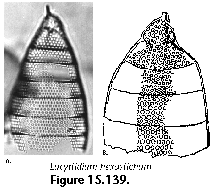 |
Eucyrtidium hexastichum (Haeckel) (Figure 15.139). Cylindrical or cnical shell with
up to 9-10 segments, thin-walled, with pores arranged in
transversal rows. Maximum shell width: 65-80 Ám. Ref: Petrushevskaya
(1971a).
|
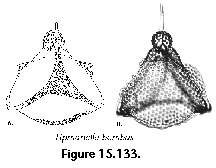 |
Lipmanella bombus (Haeckel) (Figure 15.133) [=Dictyoceras cf. pyramidale].
Very characteristic thorax where the dorsal and main
lateral spines, which project down and sideways, are
surmounted by latticed keels; these keels define the
three slightly concave sides of the pyramidal thorax.
Maximum shell width: 80-150 Ám. Ref: Benson (1966), Petrushevskaya
(1971a).
|
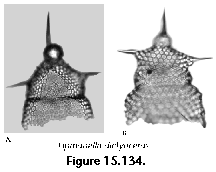 |
Lipmanella dictyoceras (Haeckel) (Figure 3R, 15.134) [=Lipmanella virchowii, Dictyoceras
virchowii, Dictyoceras neglectum]. Cephalis
large, hemispherical, wih a conspicuous apical horn.
Thorax thin-walled, conical-inflated, with three wings
(dorsal and main lateral spines). Abdomen absent or
rudimentary. Shell height: 90-130 Ám. Ref: Petrushevskaya
(1971a).
|
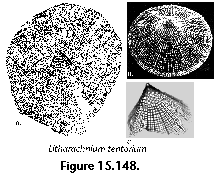 |
Litharachnium tentorium Haeckel (Figure 15.148). Two-segmented, very
characteristic shell. Cephalis very small, spherical,
hyaline. Thorax conical proximally, flaring rapidly
outward distally and, in complete specimens, ending in a
gently curved brim. Diameter of fully-grown shells: up to
1 mm. Ref: Benson (1966), Petrushevskaya (1971a).
|
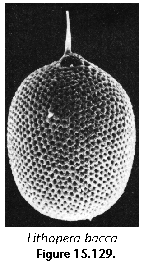 |
Lithopera bacca Ehrenberg (Figure 15.129). Spherical, often rough cephalis
with an eccentrically located apical horn partly
submerged into an oval thorax with closed mouth. Pores on
thorax regularly arranged. Shell height: 120-140 Ám.
Ref: Benson (1966).
|
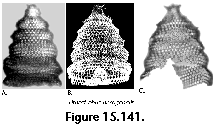 |
Lithostrobus hexagonalis
Haeckel (Figure 15.141). Multisegmented, subconical shell
with 5-9 joints with well marked strictures and angular
shoulders. Pores very regular, subpolygonal, in
transverse rows. Shell height: 120-300 Ám. Ref: Benson (1966).
|
 |
Perypiramis circumtexta Haeckel (Figure 15.130) [=?Plectopyramis dodecomma].
Cephalis very small, ovate, hyaline. Thorax large,
conical, with ca. 10 well defined longitudinal rows of
subquadrate pores rapidly increasing in size toward the
base. Pores are usually not aligned transversely. The
form described as Plectopyramis dodecomma Haeckel
differs from P. circumtexta in that pores are
aligned transversely as well as longitudally. Bathropyramis
woodringi is also similar to the above, but has
thicker longitudinal bars and aligned horizontal
(transverse) bars. Shell height: 100-300 Ám. Ref: Riedel (1958), Nigrini and Moore
(1979).
|
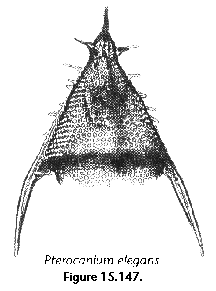 |
Pterocanium elegans (Haeckel) (Figure 15.147). Cephalis relatively small, with
two large horns (apical and vertical spines). Thorax a
large, thin-walled, three-sided pyramid with small, very
regular subcircular pores and thin bars; edges of pyramid
continue as three strong three-bladed legs. Abdomen
cylindrical, may be rudimentary. Shell height (without
horns): 180-260 Ám. Ref: Benson (1966), as Pterocanium cf. elegans.
|
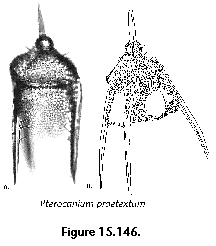 |
Pterocanium praetextum (Ehrenberg) group? (Figure 15.146). Similar to P. trilobum,
from which it sometimes is difficult to separate; differs
by having a thorax with more pronounced, angular
shoulders, and often a better developed abdomen. Shell
height (without horn and feet): 100-120 Ám. Ref: Petrushevskaya
(1971a).
|
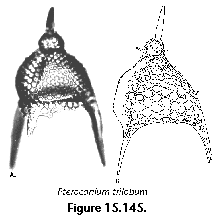 |
Pterocanium trilobum (Haeckel) (Figure 3H; 15.145). Cephalis relatively small, with a
stout apical horn. Thorax an inflated tetrahedron with
regularly arranged circular pores, with three ribs
extending into stout, three-bladed, slightly curved feet.
Abdomen, when present, rudimentary. Shell height (without
horn and feet): 100-120 Ám. Ref: Nigrini and Moore
(1979).
|
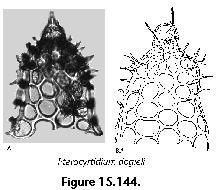 |
Pterocyrtidium dogieli Petrushevskaya (Figure 15.144) [=Sethoconus dogieli].
Cephalis hemispherical, almost poreless, thick-walled.
Thorax cylindrical, thorny, with very large, irregular,
subcircular pores. Shell height: ca. 140 Ám. Ref: Petrushevskaya
(1971a).
|
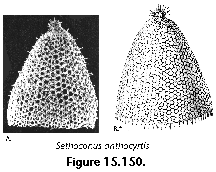 |
Sethoconus anthocyrtis Haeckel (Figure 15.150) [=Conarachnium polyacanthum,
Lophocorys polyacantha]. Cephalis spherical, spiny.
Thorax clearly differentiated from cephalis, very large,
conical, spiny, with large, regular, subpolygonal pores
approximately in longitudinal rows; termination ragged.
Shell height: 200-300 Ám. Ref: Haeckel (1887).
|
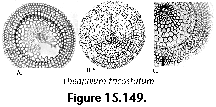 |
Theopilium tricostatum (Haeckel) (Figure 15.149) [=?Theocalyptra gegenbauri].
Chinese peasant hat-like shell with a small cephalis.
Thorax widely open, with small, regularly arranged pores,
circular proximally and becoming larger and more
polygonal distally, with three conspicuous symmetrical
ribs (dorsal and main lateral spines). Abdominal brim
flat, with 5-8 rows of very regular, quadrangular pores.
Shell diameter: 130-300 Ám. Ref: Haeckel (1887), Benson (1966).
|


























